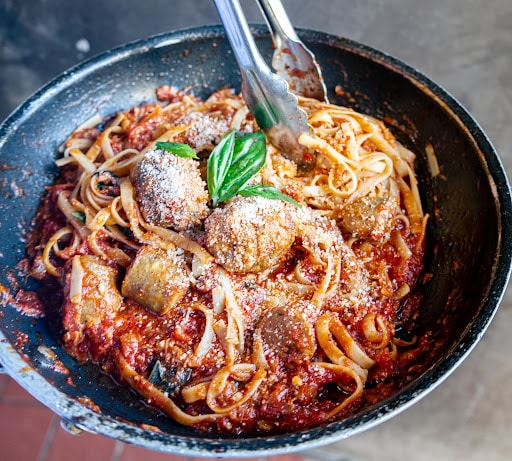Understanding Pasta Sauce Consistency
Why Sauce Consistency Matters
The consistency of pasta sauce plays a crucial role in the overall dining experience. A sauce that is too thin can lead to a watery dish, where the flavors are diluted and do not adhere well to the pasta. Conversely, a thick sauce can enhance the flavor profile, providing a rich and satisfying mouthfeel.
Common Reasons for Thin Sauce
Several factors can contribute to a pasta sauce being too thin, including:
- Excess Liquid: Adding too much broth, wine, or water can dilute the sauce.
- Vegetable Moisture: Certain vegetables release a lot of water when cooked, contributing to a thinner sauce.
- Insufficient Cooking Time: Not allowing the sauce to simmer long enough can prevent it from thickening naturally.
Methods to Thicken Pasta Sauce
There are multiple techniques to thicken pasta sauce, each with its own advantages. Below are some of the most effective methods:
1. Simmering and Reducing
Description: One of the simplest methods to thicken pasta sauce is to simmer it for an extended period. This allows excess water to evaporate, concentrating the flavors and thickening the sauce.How to Do It:
- Place the sauce in a saucepan over medium heat.
- Allow it to simmer uncovered, stirring occasionally to prevent sticking.
- Continue simmering until the sauce reaches the desired thickness.
Benefits: This method intensifies flavors and does not require additional ingredients.
2. Adding a Roux
Description: A roux is a mixture of fat (usually butter) and flour, cooked together to create a thickening agent.How to Make a Roux:
- In a separate saucepan, melt 1/4 cup of butter over medium heat.
- Add an equal amount of flour (1/4 cup) and whisk continuously for about 2 minutes.
- Gradually whisk the roux into the warm pasta sauce.
- Bring the sauce to a gentle simmer; it should thicken quickly.
Benefits: A roux adds a velvety texture and can enhance the flavor of the sauce.
3. Using Cornstarch Slurry
Description: Cornstarch is a powerful thickening agent that works quickly.How to Make a Cornstarch Slurry:
- Mix 1 tablespoon of cornstarch with 1 tablespoon of cold water in a small bowl.
- Stir until smooth, then add the slurry to the simmering sauce.
- Stir continuously until the sauce thickens.
Benefits: This method is quick and effective, making it ideal for last-minute adjustments.
4. Incorporating Starchy Pasta Water
Description: The water used to cook pasta contains starch that can help thicken sauces.How to Use Pasta Water:
- Before draining the pasta, reserve 1 cup of the cooking water.
- Gradually add 1/4 cup of pasta water to the sauce while stirring.
- Continue to simmer until the sauce thickens to your liking.
Benefits: This method enhances the sauce’s flavor and helps it adhere to the pasta.
5. Adding Tomato Paste
Description: Tomato paste is a concentrated form of tomatoes that can thicken sauce while enhancing its flavor.How to Use Tomato Paste:
- Stir in 1-2 tablespoons of tomato paste into the sauce.
- Allow it to simmer for a few minutes to integrate the flavors.
Benefits: This method not only thickens the sauce but also deepens its tomato flavor.
6. Using Cream or Cheese
Description: Adding heavy cream or grated cheese can create a rich, thick sauce.How to Use Cream or Cheese:
- Stir in 1/2 cup of heavy cream or a handful of grated cheese (like Parmesan) into the sauce.
- Allow it to simmer until the sauce thickens.
Benefits: This method adds richness and creaminess to the sauce.
7. Adding Pureed Vegetables
Description: Pureeing cooked vegetables can add body and thickness to the sauce.How to Use Pureed Vegetables:
- Cook vegetables like carrots, zucchini, or bell peppers until soft.
- Blend them until smooth, then stir the puree into the sauce.
Benefits: This method adds nutritional value and can enhance the flavor profile.
8. Using Breadcrumbs
Description: Breadcrumbs can absorb liquid and help thicken sauces.How to Use Breadcrumbs:
- Stir in 1/4 cup of fine breadcrumbs into the sauce.
- Allow it to simmer for a few minutes to thicken.
Benefits: This method is a great way to use leftover bread and adds texture to the sauce.
9. Adding Mashed Potatoes
Description: Mashed potatoes can be used to thicken sauces while adding a creamy texture.How to Use Mashed Potatoes:
- Stir in a small amount of mashed potatoes into the sauce.
- Mix until fully incorporated.
Benefits: This method adds a unique flavor and texture to the sauce.
10. Using Gelatin
Description: Gelatin can be used as a thickening agent for sauces, especially in a more formal dining setting.How to Use Gelatin:
- Dissolve 1 tablespoon of gelatin in a small amount of warm water.
- Stir the dissolved gelatin into the sauce and allow it to simmer.
Benefits: This method provides a smooth, glossy finish to the sauce.
Table: Summary of Thickening Methods
| Method | Description | Benefits |
|---|---|---|
| Simmering | Evaporates excess water | Intensifies flavors |
| Roux | Mixture of fat and flour | Adds velvety texture |
| Cornstarch Slurry | Mixture of cornstarch and water | Quick and effective |
| Starchy Pasta Water | Reserved pasta cooking water | Enhances flavor and adherence |
| Tomato Paste | Concentrated tomato form | Thickens and deepens flavor |
| Cream or Cheese | Adds richness | Creates a creamy texture |
| Pureed Vegetables | Blended soft vegetables | Adds nutrition and flavor |
| Breadcrumbs | Absorbs liquid | Uses leftover bread and adds texture |
| Mashed Potatoes | Incorporates creamy potatoes | Unique flavor and texture |
| Gelatin | Dissolved gelatin as a thickener | Smooth, glossy finish |
For further information on sauces, you can refer to the Wikipedia page on Sauce.
FAQ Section
What is the best way to thicken pasta sauce?
The best method depends on your preference, but simmering to reduce excess liquid is often the simplest and most effective way.
Can I use flour instead of cornstarch to thicken my sauce?
Yes, flour can be used, but it requires cooking longer to eliminate the raw flour taste. A roux is a common way to incorporate flour.
How does pasta water help thicken sauce?
Pasta water contains starch released during cooking, which helps to thicken the sauce and improve its ability to cling to pasta.
Will adding tomato paste change the flavor of my sauce?
Yes, tomato paste will deepen the tomato flavor, so it’s best used in moderation if you want to maintain a lighter flavor profile.
How long should I simmer my sauce to thicken it?
Simmering times can vary, but generally, 15-30 minutes should be sufficient to achieve a thicker consistency, depending on the initial liquid content.
Can I thicken my sauce with vegetables?
Yes, pureed or mashed vegetables can add thickness and nutrition to your sauce while enhancing the overall flavor.
Is it possible to over-thicken my pasta sauce?
Yes, adding too much thickening agent can lead to a sauce that is overly thick or gummy. It’s best to add thickening agents gradually.
What should I do if my sauce is too thick?
If your sauce becomes too thick, you can thin it out by adding a small amount of water, broth, or reserved pasta cooking water until you reach the desired consistency.
Can I freeze thickened pasta sauce?
Yes, thickened pasta sauce can be frozen. Just make sure to cool it completely before transferring it to an airtight container.
Are there any alternatives to traditional thickening agents?
Yes, alternatives like pureed beans, lentils, or even nut butters can be used to thicken sauces while adding unique flavors and nutrients.
Conclusion
Thickening pasta sauce is an essential skill for any home cook. By understanding the various methods available, you can achieve the perfect consistency for your sauces, enhancing the overall flavor and texture of your pasta dishes. Whether you choose to simmer, add a roux, or incorporate starchy pasta water, each technique offers unique benefits that can elevate your culinary creations. With practice and experimentation, you can master the art of sauce thickening, ensuring that your pasta dishes are always a hit.



